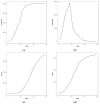Mental Health Problems during the COVID-19 Pandemics and the Mitigation Effects of Exercise: A Longitudinal Study of College Students in China
- PMID: 32466163
- PMCID: PMC7277113
- DOI: 10.3390/ijerph17103722
Mental Health Problems during the COVID-19 Pandemics and the Mitigation Effects of Exercise: A Longitudinal Study of College Students in China
Abstract
(1) Background: The novel coronavirus disease 2019 (COVID-19) is a global public health emergency that has caused worldwide concern. Vast resources have been allocated to control the pandemic and treat patients. However, little attention has been paid to the adverse impact on mental health or effective mitigation strategies to improve mental health. (2) Purpose: The aim of this study was to assess the adverse impact of the COVID-19 outbreak on Chinese college students' mental health, understand the underlying mechanisms, and explore feasible mitigation strategies. (3) Methods: During the peak time of the COVID-19 outbreak in China, we conducted longitudinal surveys of sixty-six college students. Structured questionnaires collected information on demographics, physical activity, negative emotions, sleep quality, and aggressiveness level. A mixed-effect model was used to evaluate associations between variables, and the mediating effect of sleep quality was further explored. A generalized additive model was used to determine the dose-response relationships between the COVID-19 death count, physical activity, and negative emotions. (4) Results: The COVID-19 death count showed a direct negative impact on general sleep quality (β = 1.37, 95% confidence interval [95% CI]: 0.55, 2.19) and reduced aggressiveness (β = -6.57, 95% CI: -12.78, -0.36). In contrast, the COVID-19 death count imposed not a direct but an indirect impact on general negative emotions (indirect effect (IE) = 0.81, p = 0.012), stress (IE = 0.40, p < 0.001), and anxiety (IE = 0.27, p = 0.004) with sleep quality as a mediator. Moreover, physical activity directly alleviated general negative emotions (β = -0.12, 95% CI: -0.22, -0.01), and the maximal mitigation effect occurred when weekly physical activity was about 2500 METs. (5) Conclusions: (a) The severity of the COVID-19 outbreak has an indirect effect on negative emotions by affecting sleep quality. (b) A possible mitigation strategy for improving mental health includes taking suitable amounts of daily physical activity and sleeping well.
Keywords: coronavirus; mental health; mitigation strategies; physical activity; sleep quality.
(c) The COVID-19 outbreak has reduced people's aggressiveness, probably by making people realize the fragility and preciousness of life.
Conflict of interest statement
The authors declare no conflict of interest.
Figures




References
-
- Wang L., Zhang L., Armour C., Cao C., Qing Y., Zhang J., Liu P., Zhang B., Wu Q., Zhao Z., et al. Assessing the underlying dimensionality of DSM-5 PTSD symptoms in Chinese adolescents surviving the 2008 Wenchuan earthquake. J. Anxiety Disord. 2015;31:90–97. doi: 10.1016/j.janxdis.2015.02.006. - DOI - PubMed
Publication types
MeSH terms
Grants and funding
- None/Beijing Key Laboratory of Indoor Air Quality Evaluation and Control/International
- 2019QD037/the Innovative Youth Program at Beijing Sport University/International
- 16BTY065/the National Social Science Fund of China funded by Chinese Government/International
- 2016THZWLJ12/the Leading Talents of Independent Research Program funded by Tsinghua University/International
LinkOut - more resources
Full Text Sources
Medical

